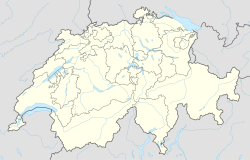Lignerolle
| Lignerolle | ||
|---|---|---|

Municipal administration of Lignerolle
|
||
|
||
| Coordinates: 46°44′N 06°27′E / 46.733°N 6.450°ECoordinates: 46°44′N 06°27′E / 46.733°N 6.450°E | ||
| Country | Switzerland | |
| Canton | Vaud | |
| District | Jura-Nord Vaudois | |
| Government | ||
| • Mayor |
Syndic Jean-Claude Nicod |
|
| Area | ||
| • Total | 10.66 km2 (4.12 sq mi) | |
| Elevation | 760 m (2,490 ft) | |
| Population (Dec 2015) | ||
| • Total | 390 | |
| • Density | 37/km2 (95/sq mi) | |
| Demonym(s) | Les Lignerollois Les Bœufs |
|
| Postal code | 1357 | |
| SFOS number | 5755 | |
| Surrounded by | L'Abergement, Les Clées, Ballaigues, France (pays) | |
| Website |
website missing Profile (French), SFSO statistics |
|
Lignerolle is a municipality in the district of Jura-Nord Vaudois in the canton of Vaud in Switzerland.
Lignerolle is first mentioned around 1160–64 as de Lineroles.
Lignerolle has an area, as of 2009[update], of 10.7 square kilometers (4.1 sq mi). Of this area, 5.17 km2 (2.00 sq mi) or 48.5% is used for agricultural purposes, while 4.94 km2 (1.91 sq mi) or 46.3% is forested. Of the rest of the land, 0.5 km2 (0.19 sq mi) or 4.7% is settled (buildings or roads) and 0.03 km2 (7.4 acres) or 0.3% is unproductive land.
Of the built up area, housing and buildings made up 1.5% and transportation infrastructure made up 2.9%. Out of the forested land, 41.8% of the total land area is heavily forested and 4.5% is covered with orchards or small clusters of trees. Of the agricultural land, 14.7% is used for growing crops and 14.5% is pastures and 18.9% is used for alpine pastures.
The municipality was part of the Orbe District until it was dissolved on 31 August 2006, and Lignerolle became part of the new district of Jura-Nord Vaudois.
The municipality is located on the slopes of Suchet mountain.
The blazon of the municipal coat of arms is Or, a Buck passant Gules.
Lignerolle has a population (as of December 2015[update]) of 390. As of 2008[update], 10.2% of the population are resident foreign nationals. Over the last 10 years (1999–2009 ) the population has changed at a rate of 17.4%. It has changed at a rate of 13.4% due to migration and at a rate of 4% due to births and deaths.
Most of the population (as of 2000[update]) speaks French (316 or 94.6%), with German being second most common (10 or 3.0%) and Italian being third (3 or 0.9%).
...
Wikipedia




